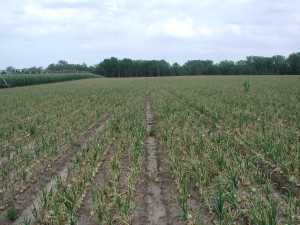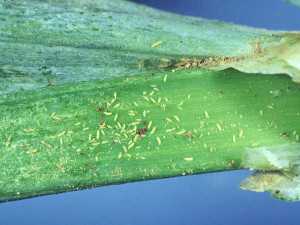Tips On Managing Onion Thrips
Onion thrips are a major onion pest and feeding damage can cause yield reductions of 30% to 50%. In addition, onion thrips transmit iris yellow spot virus, and the damage caused by their feeding can enable secondary pathogens to infect the crop.
Insecticides manage onion thrips and are very effective at reducing populations. However, past lessons with pyrethroid resistance highlight the importance of using these products only when necessary, and rotating different chemistries to delay development of insecticide resistance in these populations.

Thrips transmitted iris yellow spot virus
severely damaged the onion plants in this field.
Photos credit: Brian Nault.
An insecticide resistance management (IRM) plan developed at Cornell University outlines which insecticides to use, and how many times to apply an active ingredient before switching to another that belongs to a unique class of chemistry. The goal is to expose each generation of thrips that develops over the growing season to a single active ingredient so that resistant individuals don’t continue to cause damage and produce resistant offspring.
Determine Scale For IRM Plan
While insecticide rotation is a very effective way to delay insecticide resistance, there are several factors that could interfere with the effectiveness of this strategy for onion thrips. The first has to do with determining the scale at which you’ll need to conduct your IRM plans.
To ensure that resistant offspring don’t persist, the IRM plan must be implemented at a scale that corresponds to the area inhabited by a population of onion thrips (i.e. according to how far onion thrips travel to reproduce). The second has to do with characteristics of the onion thrips populations themselves.
Spatial Considerations
Rotating insecticides from different classes is an effective way of delaying insecticide resistance from developing in pest populations. However, problems with this strategy occur when there is non-compliance or uncoordinated efforts by growers occurring in areas inhabited by the same insect population. As an example of non-compliance, think of two onion fields, A and B, planted next to each other but managed by different growers.
Grower A implements a chemical rotation IRM strategy, whereas grower B always sprays the same insecticide. In time, grower B will end up selecting for insects that are resistant to the insecticide being used, and will suffer crop losses. In addition, it is likely that resistant insects from field B will end up in field A because the distance between the fields is small enough that insects can move between them. As a result, grower A might suffer crop damage because of neighbor B not implementing an IRM strategy.
Five Tips To Manage Insecticide Resistance
- Manage pests without insecticides whenever possible by planting insect-tolerant cultivars, rotating fields, etc.
- Maximize efficacy of insecticides by applying them properly to the crop and targeting the most susceptible life stage.
- Limit the number of insecticide applications, for example, no more than two applications of the same product per crop per season.
- Rotate insecticide classes by using products consecutively in a sequence to minimize exposure to multiple pest generations.
- Use action thresholds to determine when to spray the insecticide.
Coordinate Timing Of Sprays
In the example of uncoordinated efforts, where farmer A and B would both be implementing insecticide rotation strategies, insecticide resistance problems occur when timing of insecticide sprays and/or sequence of insecticide rotations is different.

Onion thrips are small and hard to observe, and little is known about their dispersal abilities.
If the insecticide rotation sequence is the same, but timing of insecticide applications is different, this creates a lag where there is more time for resistant individuals to survive in the fields before they are killed by the next chemical class applied. Similarly, if the timing is coordinated, but the chemical rotation strategies differ, and grower A sprays the same chemical class grower B just finished spraying, then this allows more opportunity for resistant individuals to survive, reproduce, and damage the crop.
Although these examples are between neighboring fields, these scenarios could play out over longer distances, the limits of which are as large as the dispersal capabilities of the insects. This means that farmer A and B only have to coordinate their efforts if thrips are actively moving between their fields.
Unfortunately, thrips are small and hard to observe, and therefore, little is known about their dispersal abilities. In addition, we know thrips can disperse long distances on wind currents; however, we don’t know how far they travel or how often this occurs.
Use Genetic Tools
One way to investigate movement of thrips without directly monitoring them is to use genetic tests to determine whether thrips from different mucks are related to each other. This information can then be used to determine whether IRM plans targeted against onion thrips in specific states need to be coordinated at local or regional scales.
If there are different strains of onion thrips, this means they need to be examined separately with regard to IRM because they could differ in characteristics related to insecticide resistance. However, if onion thrips strains are similar, then how far individuals travel to reproduce will be important.
Until recently, researchers at Cornell did not have genetic tests available to look at population-level associations among onion thrips. Now they can determine whether there are different populations or different strains of thrips to ensure they have the information about thrips they need to develop effective, long-term management strategies.
Current research underway at Cornell includes using a combination of tests that detect ancestral and population-level genetic differences, and they are currently in the process of examining the genetic relationships of onion thrips collected from onion mucks across New York.
By doing this, researchers hope to better understand if thrips populations are isolated in different mucks, or if they disperse to surrounding areas, and if so, how far they travel. The information will be used to help develop IRM plans that will be more effective at delaying the development of insecticide resistance and increase the longevity of the few effective chemical options that exist for onion thrips control in onion.
Editor’s Note: Alana Jacobson ([email protected]), and George Kennedy, ([email protected]), both in the Department of Entomology at North Carolina State University, also contributed to this article.









